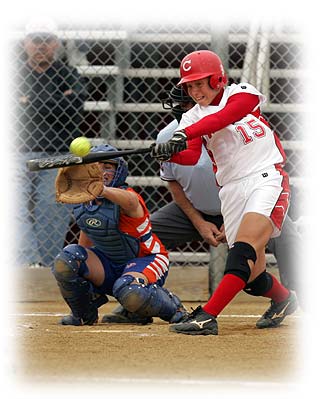The following are keys to power hitting that I have studied, practiced, and taught to players and coaches.
1) A Strong and Stable Athletic Stance is the foundation for power throughout the entire swing from stance to swing to follow-through. This answers the question on being on your toes with heels up to stride or hit.

2) Leverage is better understood when the ground is used to initiate power through the legs, transferred through the core, and out through the arms and hands. A key to success is initiating the back foot pivot with the back heel lower to the ground and then on explosion through the ball push the heel from the ground to a higher ankle/foot position as the power is transferred through the ball. If the heel remains low to the ground, weight stays back and power is never transferred.
3) Powering into a Long Lever achieves the greatest kinesis success in hitting. This can be accomplished by more and shorter levers unlocking into the lone lever, ie, shoulder/elbow/knob/ wrist to contact, then extension. This eliminates the thinking of “barring the front side” as I hear on the East Coast, or in other words, straightening the arm prior to contact with the ball and beyond.
4) Extension is critical. I find this to be misunderstood or misinterpreted. Picture two jugs, one at the point of contact and another about 6 -12 inches in front of the contact point. Typically we find contact at one speed and the extension measurement substantially less in speed. I believe that if a player is serious about increasing power and distance, then she must work hard to maintain speed through contact until follow-through. I use a 1 – 2 – 3 – 4 diagram to explain extension. 1) launching position 2) contact point 3) extension point, and 4) follow-through. We focus on 2 – 3 as the most important part of the swing process with 1 – 2 close in importance and 3 – 4 the least important. At no time however can a batter shortcut 1 – 2 – 3 – 4 by skipping a part.
5) Bat Speed is always discussed as a help, but its purpose is better understood as a statistic. In Fastpitch, we understand that for every five miles per hour of bat speed increase in the swing, an increase of up to 15 percent can be realized in distance. This is similar to baseball where it has been tested that for every five m.p.h. increase in bat speed a 40 – foot additional distance is gained.
6) “Eighty Percent Hips” is a concept that needs to be understood to maintain stability. Players need to be taught to pivot hard and pop their hips, but not beyond balance and control. So trying to turn hips 100 percent is usually out of control. Along with the hips at 80 -90 percent we must always use 100 percent speed with our hands. We could call this the “80 – 100 rule.”
7) Popping Hips for power is also a little misunderstood. A hitter must pop her back hip against a firm front side to get the most pop on the ball. Popping her hips is a movement that isn’t just turning (or closing) the pelvis hard, but a movement forward and slightly up and out. This gives the best pop from the body.
8) A trigger is most important to power simply because a player must go back before she goes forward. In every athletic endeavor today – from tennis to bowling to Fastpitch – to generate force, one has to load up to generate maximum force. I realize in Fastpitch we balance this with efficiency to come up with the proper combo. A little trigger movement with the front knee, hip, and shoulder away from the pitch will load up the body properly for explosion. Simultaneous with a stride step forward adds critical timing to the swing (matching movement with the pitcher’s movement.)
9) Rhythm and Tempo are key factors in movement and to perfect practice. Eliminate stopping anywhere in the swing to enhance quickness and power to the ball. Getting the most out of the entire body is critical. Fluidity of movement enhances power. Fluidity is measured by tempo. Slow loading to quick explosion helps achieve this in hitting.
10) Path to the Ball and Swing Efficiency aid in power by not allowing wasted energy going away from the body (casting or sweeping), hitching, or dragging the bat through the strike zone. The bat in a finger grip fosters speed and control too.
11) Conditioning the body goes without saying. “Total Body Training” is our directive. Core strength (neck to pelvis) is essential. Developing muscle control throughout a full range of movement not beyond an individual’s anatomical limits (D’ROM) is our goal. Stability in our rotational movements are the key to success in Fastpitch. Developing forearm strength and aiding the fast twitch fibers in those muscles to fire faster will enhance bat speed too.
12) Eyes Scanning and Converging are part of our training to focus better, see the ball bigger, and become more disciplined at the plate to pick out better pitches in the right situation. i.e. the batter’s performance strike zone. The movement of the eyes are more important than the head. Positioning the head is important to see the release and contact without any head movement. We must see the release and contact with both eyes clearly. Tracking the ball with the head IS NOT correct.
13) Proper and Maximal Performance Equipment is undeniably a key factor in the game today, especially with the technological advancements these days. We are pushing the limits even with more recent controls and testing guidelines. A player today, to be competitive, must get the most advantage out of her equipment.